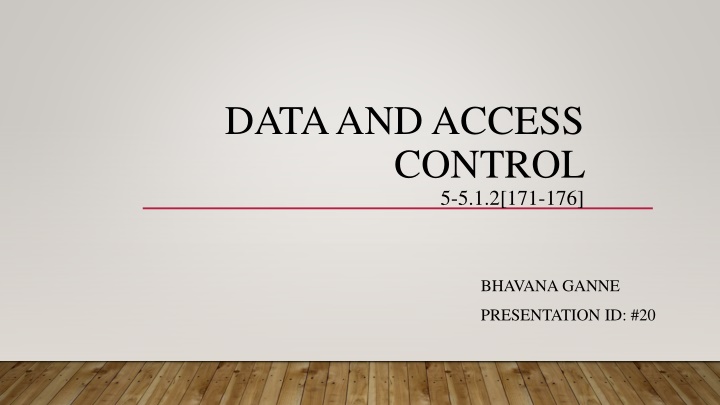
Semantic Data Control and View Management in Database Systems
Learn about the importance of semantic data control and view management in database systems, including how they ensure data integrity, security, and logical data independence. Explore how views are defined and utilized to provide a dynamic window into the database, enhancing data security and access control.
Download Presentation

Please find below an Image/Link to download the presentation.
The content on the website is provided AS IS for your information and personal use only. It may not be sold, licensed, or shared on other websites without obtaining consent from the author. If you encounter any issues during the download, it is possible that the publisher has removed the file from their server.
You are allowed to download the files provided on this website for personal or commercial use, subject to the condition that they are used lawfully. All files are the property of their respective owners.
The content on the website is provided AS IS for your information and personal use only. It may not be sold, licensed, or shared on other websites without obtaining consent from the author.
E N D
Presentation Transcript
DATA AND ACCESS CONTROL 5-5.1.2[171-176] BHAVANA GANNE PRESENTATION ID: #20
OUTLINE.. Semantic Data Control View Management View Management in Centralized DBMS Views in Distributed DBMS
SEMANTIC DATA CONTROL Semantic data control typically includes view management, security control and semantic integrity control. These functions must ensure that authorized users perform correct operations on the database, contributing to the maintenance of database integrity. Views, Security constraints, and Semantic integrity constraints can be defined as rules that the system automatically enforces in a uniform way.
VIEW MANAGEMENT Views enable full logical data independence. Views are virtual relations that are defined as the result of a query on base relations. Views are typically not materialized Can be considered a dynamic window that reflects all relevant updates to the database. Views are very useful for ensuring data security in a simple way By selecting a subset of the database, views hide some data. Users cannot see the hidden data.
A view is a relation that is derived from a base relation via a query. It can involve selection, projection, aggregate functions, etc. Example: The view of system analysts derived from relation EMP CREATE VIEW SYSAN (ENO, ENAME) AS SELECT ENO, ENAME FROM EMP WHERE TITLE = Syst.Anal.
Queries expressed on views are translated into queries expressed on base relations Example: Find the names of all the system analysts with their project number and responsibility? -Involves the view SYSAN and the relation ASG(ENO,PNO,RESP,DUR) SELECT ENAME, PNO, RESP FROM SYSAN, ASG WHERE SYSN.ENO = ASG.ENO
- is translated into SELECT ENAME,PNO,RESP FROM EMP, ASG WHERE EMP.ENO = ASG.ENO AND TITLE = "Syst. Anal." Automatic query modification is required, i.e., ANDing query qualification with view qualification
All views can be queried as base relations, but not all view can be updated as such Updates through views can be handled automatically only if they can be propagated correctly to the base relations We classify views as updatable or not-updatable. Updatable view: The updates to the view can be propagated to the base relations without ambiguity.
CREATE VIEW SYSAN(ENO,ENAME) AS SELECT ENO,ENAME FROM EMP WHERE TITLE="Syst. Anal. - Eg, insertion of tuple (201,Smith) can be mapped into the insertion of a new employee (201, Smith, Syst. Anal. ) - If attributes other than TITLE were hidden by the view, they would be assigned the value null.
Non-updatable view: The updates to the view cannot be propagated to the base relations without ambiguity. CREATE VIEW EG(ENAME,RESP) AS SELECT ENAME,RESP FROM EMP, ASG WHERE EMP.ENO=ASG.ENO
CREATE VIEW EG(ENAME,RESP) AS SELECT ENAME,RESP FROM EMP, ASG WHERE EMP.ENO=ASG.ENO e.g, deletion of (Smith, Syst. Anal. ) is ambiguous, i.e., since deletion of Smith in EMP and deletion of Syst. Anal. in ASG are both meaningful, but the system cannot decide.
Current systems are very restrictive about supporting updates through views Views can be updated only if they are derived from a single relation by selection and projection. However, it is theoretically possible to automatically support updates of a larger class of views, e.g., joins
VIEWS IN DISTRIBUTED DATABASES Definition of views in DDBMS is similar as in centralized DBMS However, a view in a DDBMS may be derived from fragmented relations stored at different sites. Views are conceptually the same as the base relations, therefore we store them in the (possibly) distributed directory/catalog Thus, views might be centralized at one site, partially replicated, fully replicated. Queries on views are translated into queries on base relations, yielding distributed queries due to possible fragmentation of data.
A materialized view stores the tuples of a view in a database relation, like the other database tuples, possibly with indices. A materialized view is much faster than deriving the view, in particular, in a distributed DBMS where base relations can be remote. Example- The following view over relation PROJ(PNO,PNAME,BUDGET,LOC) gives, for each location, the number of projects and the total budget. CREATE VIEW PL(LOC, NBPROJ, TBUDGET) AS SELECT LOC, COUNT(*),SUM(BUDGET) FROM PROJ GROUP BY LOC
Materialized views have gained much interest in the context of data warehousing to speed up On Line Analytical Processing (OLAP) applications. Materialized views in data warehouses typically involve aggregate(such as SUM and COUNT) and grouping (GROUP BY) operators because they provide compact database summaries. Today, all major database products support materialized views.
